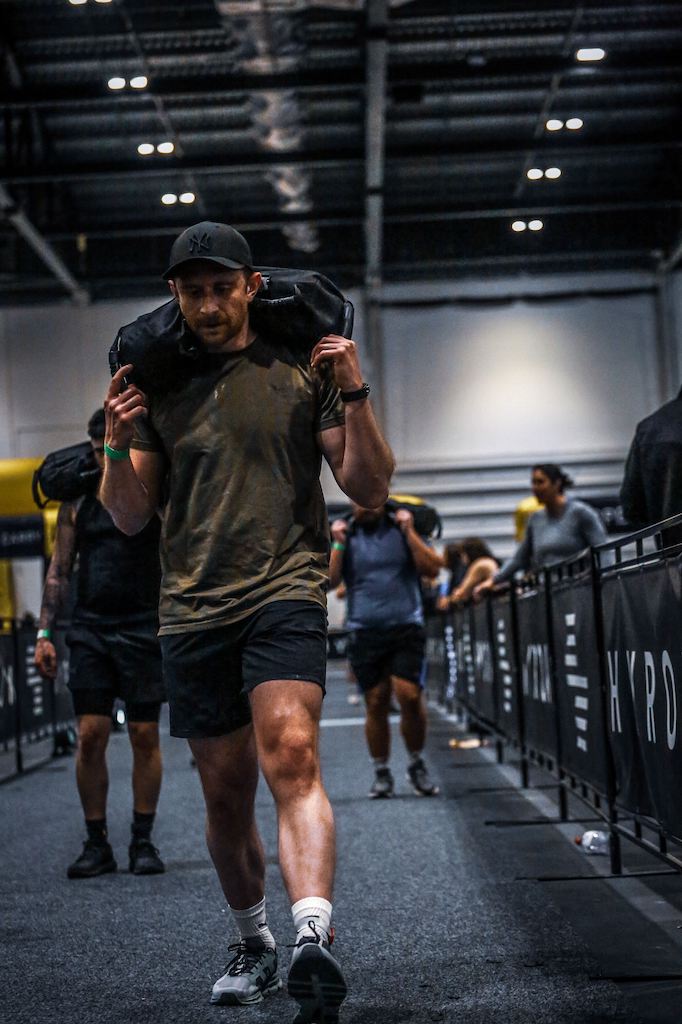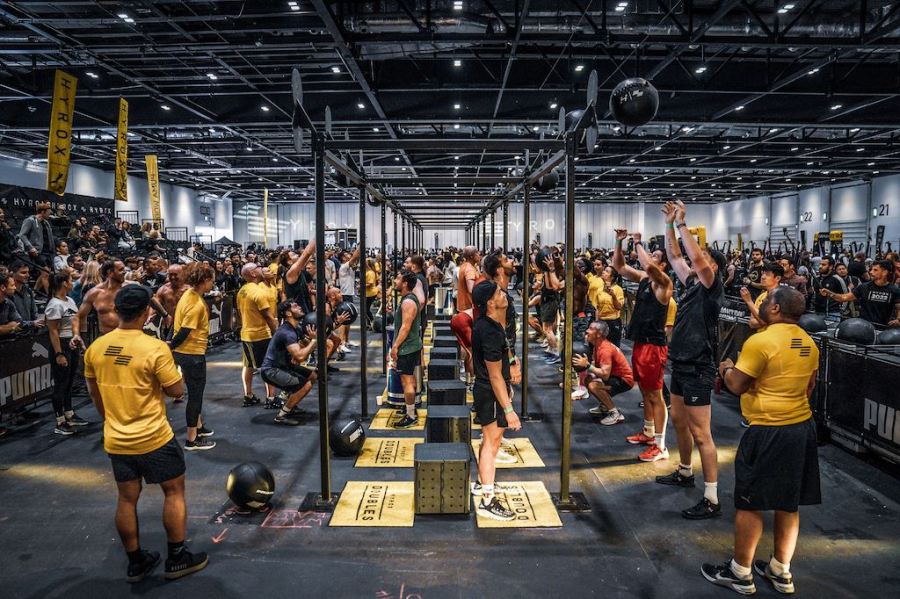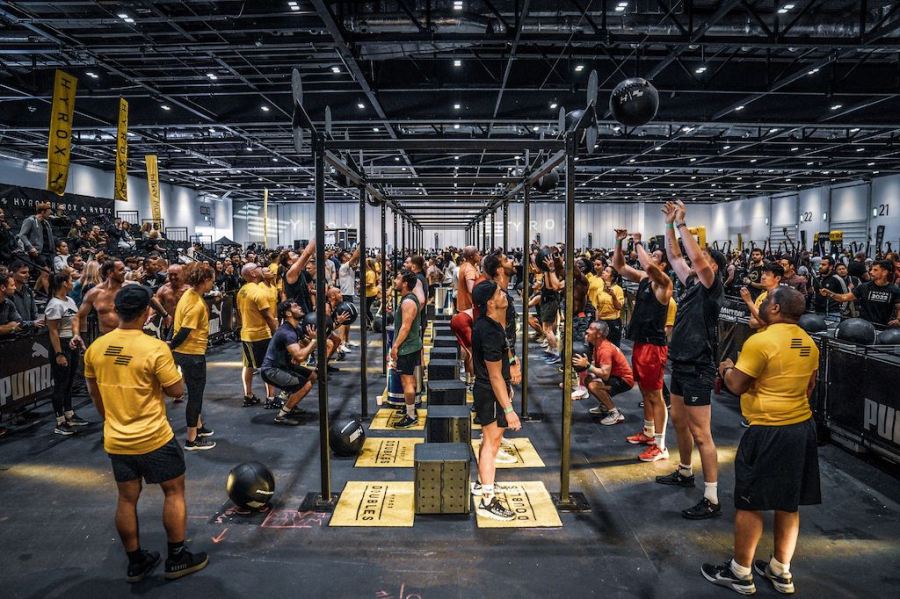Men’s Fitness editor Isaac Williams reports from HYROX London, where he discovers it’s not an event for the ill-prepared or weak-legged.
It’s 2:45pm in late April. One of the hottest days of the year to date, and I’m doing laps of a windowless exhibition hall in East London’s sprawling ExCeL Centre. I’m desperately trying to keep panicked lungs from exploding out of my chest.
The obvious question being, ‘Why?’
I’m putting my body through some grade A punishment in the name of HYROX, the new event on the functional fitness block. You may have read our introductory feature last year, but if you missed it, here’s a quick recap.
What is HYROX?
Billing itself as the ‘World Series of Fitness’, HYROX events all follow the same formula; eight x 1km of running, interspersed with eight different exercise stations, designed to test every facet of fitness.
Unlike CrossFit, there are few highly technical movements or specialist kit. The idea is that the formula can be easily replicated – and trained for – in commercial gyms with standard equipment.
The greater emphasis on running means the conditioning demands are different, too. Beef cakes might make light work of the sled push and sled pull. However, a lack of cardio fitness is going to make the running, burpee broad jumps, SkiErg and even wall balls (more on those later) very painful indeed.
There are four categories on offer: Individual, Pro, Doubles and Relay – with each divided into men’s and women’s. I entered into the Individual. The difference between that and Pro is slightly lighter weights and a greater proportion of men with their tops on. I arrived with a blissful ignorance as to what was in store.
What to expect from HYROX
It’s a calm state of mind that’s immediately threatened as soon as I get to the event – which is heard before it’s seen. Dance music blares from all directions. It’s interspersed by the admirably enthusiastic race announcer, calling people’s names as they cross the finish line.
Unlike other mass-participation events, HYROX is a full-day affair. Small groups of competitors set off in waves 20 minutes apart. I’m on the 2:30 shift. So, by the time I arrive there are already plenty of people with stiff legs and shell-shocked expressions.
The looks on those running around the perimeter running track isn’t much more promising. If they’re not grimacing or sucking in air, they’re simply reduced to a walk.
HYROX event layout
In the middle of the track – accessed only by finding a gap in the constant stream of runners and legging it across – is where most of the action is taking place.
To the right: a kitted-out warm-up area, offering the chance to get a feel for the stations to come; to the left, the event proper, with knee-high barriers separating spectators from weary competitors.
I take a minute to see how people are tackling the sled, burpee broad jump and wall balls. Most seem to be opting for the ‘go hard and cling on’ approach. No one is having an easy time.
However, fresh off the back of an ultramarathon (albeit a very slow one), I knew I could hack the running.
As for the other bits: 1,000m SkiErg isn’t particularly fun, but I’d get it done; the sled push and pull were complete unknowns; burpees are never enjoyable, but doable; rowing’s one of the few sources of confidence; farmer’s carries are OK; lunges are fine; and wall balls? Well, 100 is clearly a fair amount, but with 6kg – how hard can that be?
The correct answer, dear reader, is ‘very’.
How hard is HYROX?
Having navigated the first kilometre (two-and-a-bit laps around the hall), and hashed my way through the SkiErg, I snatch some water from one of the three or four drinks stations. Then, I make my way to the track for the second run section.
So far, so OK. I settle into a steady pace on the runs, using this more familiar exercise as a chance to semi-recover between the less predictable stations in-between.
But if I’m pootling along relatively unscathed at this early stage, I’m about to get a very rude sled-based awakening.
Starting the Sled Push
I finish kilometre two, leave the track and make my way to the inflatable arch indicating station two: Sled Push. A marshal directs me to a free sled and I’m instructed to push it to the end and back, twice – a total distance of 50m.
There’s 125kg of plates loaded onto it (plus the weight of the sled itself). I grip the handles with straight arms, get low to the ground and drive, as a bloke in the lane over does the same.
We set off at the same pace, inching our sleds along until they’re about halfway down. Only, at this point he keeps going. I do not.
Approximately 15 metres in, I’m done for. With jelly legs and lungs on fire, what follows is an excruciating and undignified five minutes. Eventually it’s over, but it doesn’t feel great to be this knackered this early.
Hunter McIntyre on HYROX pacing
HYROX world-record holder Hunter McIntyre doesn’t think so, either.
“Pacing is the most important thing there is,” he told MF when we spoke to him last year. “You should treat the beginning part – which is very challenging with the harder movements at the front – almost like a warm-up.
“I know how many steps I’m going to take every single set of the sled push. I also know how I’m going to breathe through my nose and exhale through my mouth, so that I can get the air out better. If you’re applying pressure to your diaphragm with that sled, all of a sudden your lung capacity is going to be slashed.”
He’s not wrong.

Editor Isaac Williams stares into the lunge-induced abyss
The next run is heavy-legged. But I try my best to pick my knees up and force some energy into my system.
Having been humbled by pushing the sled along, the prospect of pulling it isn’t filling me with confidence. But happily, the sled pull doesn’t feel nearly as tough.
With a boxed area roughly a metre long in which to work, I start at the front, pull the rope tight, squat down and step to the back. It doesn’t look as impressive as reeling the sled in with upper-body power. But it conserves some precious energy and I make it through without any drama.
With a slow plod back to the start of the running track, I find a gap and set off on kilometre number four.
Competing against yourself
By now, the 2:50 wave has set off, and it’s easy to see who is in it, as they’re surging past with the energy of people unburdened by post-traumatic sled disorder.
Which is actually one of HYROX’s key selling points: the regularity of the waves means you soon lose sight of who you started with, so the only person you compete against is yourself.
That means unlike other events, where everyone starts at the same time, there’s no immediate way of separating the quickest from the slowest finishers.
Onto the burpees
Next up is burpee broad jumps, which are predictably horrible, but the good thing about being so humbled so early on is that nothing feels quite as bad in comparison.
That said, no one enjoys burpees, and when they’re combined with an ‘explosive’ (in the loosest possible sense) leap forward they’re even worse.
I try to cover as much distance with each jump as possible, to limit the number of down-and-ups needed. It works, in the sense that this is one of the few sections I find myself overtaking people, but it doesn’t do anything for my soaring heart rate.

Struggling through the kettlebell farmer’s carry
Run, row, run, then on to the farmer’s carry. By now, my legs seem to have reluctantly accepted their fate, less sore than numbed into submission, and I’m able to make it to the end of the 200m with just the one brief rest pause at halfway – the tactic being to move as quick as possible, before forearms realise what’s happening.
A quick telling-off from a marshal (make sure you put those kettlebells back in their designated spot), then on to the penultimate run – noticeably harder than the first, but still a chance to catch the breath and prepare for the 100m of sandbag lunges.
As with the farmer’s carry, I try to get into a steady ‘go quick, don’t think’ rhythm, but the lunge is a stop-start movement and before long the lactic build-up is severe. The final 50m stretch lasts an age, but I eventually cross the line, dump the sandbag (responsibly) and shuffle away on leaden legs.
Facing the wall balls
The end finally in sight, I tick off the final kilometre – attempting but largely failing to pick up the pace – and head under the arch reading ‘Wall Balls’.
I’m basically home and dry (figuratively, of course – in reality I’m drenched in a hideous amount of sweat) and though 100 is a lot of reps of anything, the 6kg weight isn’t anything to be particularly worried about.
I take my position in front of the target, with a watchful marshal stationed directly behind me – each throw needs to hit the mark, otherwise the rep doesn’t count – pick up the ball (heavier than it should feel, but sure I’ll get used to it), squat down, stand up and chuck the ball into the air.
“No rep,” comes the call from behind.
A bad start – that only gets worse. The next ten minutes is a disasterclass in how not to do it. I lose count of the number of missed reps – between ten and 12 – and generally have a terrible time.
Eventually the 100 comes up, though not before virtually everyone who started at the same time has long since crossed the line, and I grimace my way to the finish.

Wall ball hell
Should you sign up for HYROX?
Writing this two weeks post-event, legs having just about forgiven me, I can reflect on HYROX being a genuinely well-run event.
Despite the thousands of participants, and the competition’s relative infancy, entering and exiting each workout station was a seamless, queue-free process. The exercises themselves combine to make for a challenge that, though brutally difficult, is accessible for most people with a reasonable level of fitness.
That said, if you want to enjoy the experience, or post a respectable time, don’t just rock up and hope for the best.
The SkiErg is a technical movement, so get to grips with the technique; the sled push is heavy, so train with the weight beforehand; and 100 wall balls at the end of it all is a test of mental resolve as much as strength endurance, so get at least a couple of 50-rep sets under your belt in the build-up.
Basically, do everything I didn’t.
RELATED CONTENT:








